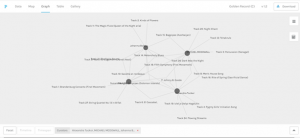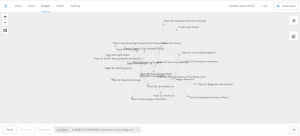When I think of algorithms, I think of advertising on my social media and predictive text on my mobile phone. I know that algorithms are embedded in more than these two elements, but I believe these are the ones I experience most. Quite frankly, my understanding of algorithms is tenuous at best. Generally, my understanding is, the more that I research or type certain things on my devices, the more these will appear to me in the form of advertising or suggested words on my device. Thus, my initial thoughts about the communities derived from our musical choices would be based on quantity of shared selections. I assumed that I would be grouped with the people with whom I had the most in common in terms of our choices.
When I compared my choices with those of each individual in the course, I noticed that I was not necessarily grouped with the individuals with whom I shared the most choices in common. Elizabeth and I share six choices in common while I share five of the same choices with each Christina and Megan. None of these individuals are in my community. Instead, I share a community with individuals who share between three and four of the same song choices as myself. This leads me to believe that the quantity of choices is not the sole factor in deciding the communities.
When looking at a more detailed view of the community of which I am a part (Image 1), there seems to be symmetry to the graph that has been created by our choices. When I filtered the curators to view only those belonging to each of the communities, each community seemed to have a similar degree of symmetry that I observed with my own. I then experimented with randomly selecting one person from each community; in this scenario, there appeared to be little or no symmetry in the graph. I then tried viewing myself and the three individuals with whom I share the most common choices, Elizabeth, Christina, and Megan (Image 2). Our graph also seemed to have less symmetry than those created by the program. Thus, it appears to me that symmetry of the relationships between choices plays some role in the creation of these communities.
While the program did not know any of the reasoning behind our choices, I viewed the blog posts of my fellow community members to try and find any similarities and understand how our community was formed. Generally, I found that everyone in my community had very different criteria for their selections. Susana seems to have based her decisions on the instruments, while Johanna chose the songs that spoke to her on an emotional level, and Michael mostly selected songs that he liked. My primary criterion was to have the songs be representative of the cultural diversity of our world which led me to make selections based on geography with the instruments represented being a second criteria. This second criterion shares a similarity with Susana, while my first has a small commonality with Michael, who’s last three songs were included in an effort to represent worldwide cultures. While the algorithm has placed the four of us into a community, it does not provide any information about the reasoning behind our choices.
After learning more about the criteria of my community members, I took a look at the criteria described by the individuals with whom I shared the most songs (Elizabeth, Christina, and Megan). Interestingly, I found our criteria were much more similar than those of my community members. All three described attempting to include songs that were representative of the diversity of the human population. Additionally, Christina’s post could even be mistaken for my own; beyond selecting songs for their cultural and instrumental representation we each described our own awareness of our Western biases.
Ultimately, I still feel a little lost when it comes to what this program has done in order to create these communities. I can see symmetry as playing some kind of role (I think), but beyond that there is a lot of information that is lost. Beyond the symmetry created by the connections within my community, I see more similarities of choices and criteria with member of two other communities. However, these criteria are not represented in the graph having not been part of the data. Reflecting about what this means in terms of society and education, I think it is a cautionary tale. While computers, programs, and algorithms might be able to identify certain trends or statistical groupings, it seems to me that these machines cannot understand the more human side. The criteria we as a class have identified range in ways that seem uniquely human. Whether is based on feelings, preferences, or the desire to represent the diversity of human cultures, I think these are things that a computer has trouble understanding unless they are reduced to some kind of code.
Image 1. My community as generated by the program. Here there seems to be a fair amount of symmetry.

Image 2. The individuals with whom I shared the most songs in common. Notice the lack of symmetry in this graph. Despite the fact that I have the most in common with each of these individuals, our network appears much more random.
